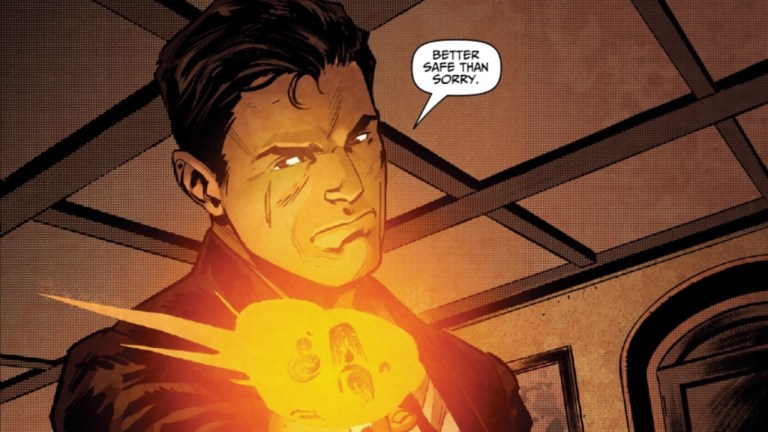The Newest James Bond Story Finally Gets This One Thing Right About Ian Fleming’s 007
The comic book James Bond: 007 by Garth Ennis and Rapha Lobosco makes Bond brutal again.

This article contains light spoilers for James Bond: 007 #1.
In the first pages of a new comic book series, a mafioso gathers his family and talks of revenge. Reeling with sorrow and anger at the murder of his son, the mafioso vows to destroy his child’s killer. As he talks, the mafioso praises the remaining members of his family, and artist Rapha Lobosco devotes a panel to each, letting the reader see their importance: his strapping sons, his beautiful daughters, his loving wife, and his elderly mother.
But just when the mafioso hits the climax of his speech, an interuption forces him to turn around. There, he sees all but his mother dead, blood pouring from a bullet hole placed precisely in their foreheads. After killing the mafioso, the gunman turns to the elderly mother and says, “Better safe than sorry.” The sequence ends with a splash page showing the gunman firing at the camera.
If you guessed that this comic comes from Garth Ennis, you are correct. The Scottish writer has made his name with brutal stories about uncaring heroes, who dispense untold violence on their depraved enemies, portrayed in gory images.
But the scene does not come from a new series of The Boys a revitalization of Punisher: Max. Rather, it comes from James Bond: 007 #1 from Dynamite Entertainment. And it’s absolutely perfect.
The Brutality of Bond
This latest take on Bond might come as a surprise for those who only know 007 from the movie franchise. The Bond made popular in films from Eon Productions is an aspirational figure, a smooth operator decked out in luxury brands (remember his expresso maker in Live and Let Die?). Save for some notable exceptions, he ends his exploits unscarred and in the arms of a beautiful woman.
To be sure, these takes do find Bond committing horrible acts of brutality. In Thunderball, Bond uses Fiona Volpe (Luciana Paluzzi) as a human shield to protect himself from an assassination attempt during a dance, dropping her dead body at a table when he’s done with her. In Diamonds Are Forever, Bond strangles a woman with her bikini top. Timothy Dalton’s Bond knocks corrupt DEA agent Ed Killifer (Twin Peaks‘s Everett McGill) into a shark tank in License to Kill. Even the debonair Pierce Brosnan Bond offs media mogul Elliot Carver (Jonathan Pryce) by dropping him into a drill at the end of Tomorrow Never Dies.
But as shocking as these moments are, the Bond films find ways of dulling or justifying the actions. Carver, Killifer, and others are bad guys getting their just rewards. The fights look cool, occurring on amazing Ken Adam sets and accompanied by a rollicking score. The natural charisma of Timothy Dalton, Sean Connery, Roger Moore, or even George Lazenby compels us to like Bond, even after his terrible acts.
Despite some initial reservations about the Scottish Connery playing 007, Bond creator Ian Fleming largely liked the adaptations he saw. However, the movie Bonds lacked the cold-blooded cruelty of the book character. Fleming claimed that he wrote his Bond books for “warm-blooded heterosexuals in railway trains, airplanes, or beds,” and while that fits the fantasy figure of the movies, his Bond had a palpable lack of feeling. He was a tool of Her Majesty’s secret service in the guise of a human being.
A Cold Comic-Book Bond
Ennis and Lobosco’s Bond has no such softness about him. A veteran of flashy books such as Vampirella and Hack/Slash, Lobosco tempers his dynamic sensibilities to let the reader see Bond’s hard edges. He draws Bond with none of the glamor of the actors who portrayed 007 in the past, and instead makes him a more unremarkable figure, befitting the dull instrument of Fleming’s works. The furrowed brow and clenched jaw that Lobosco gives Bond betrays no internal feelings, but rather operate as nothing more than mechanical functions.
Even when Bond has what could be a more sensitive moment, removing his shoes to wade in the water with retired agent Archibald Tyron, Lobosco gives him a deliberation that lacks movie star grace. He stands by Tyron not to relate with another human who knows how he feels, but to get information, a point underscored by the issue’s stomach-churning climax.
Jorge Sutil’s muted color palette furthers this morose take. Even when Sutil uses stylized colors, as with the reds that fill the frames of the aforementioned mafioso’s rant, they contrast with Bond’s calculated assassinations. Likewise, letterer Rob Steen subtly distinguishes Bond from other characters in the way they speak. When the mafioso reaches the climax of his speech, Steen uses larger letters, exaggerating them to almost bubble-letter proportions, only to return to flat letters for Bond’s sterile response.
The more muted approach by the rest of the creative team allows Ennis to indulge his nastiest impulses without breaking the reality of the book. As gratuitous as his 007 gets, Ennis’s collaborators allow Bond to remain an uncaring killer.
Let Bond Be Bad
The glitz and spectacle of Bond movies can sometimes distract from the fact that Bond is soldier for empire and capital. He kills those who would diminish England or its business interests, an inherently stomach-churning quality.
While Fleming didn’t think his warm-blooded heterosexual readers would have a problem with Bond’s moral compass, he did have the sense to portray his protagonist as a man with a broken moral compass. As the writer of some of the most unpleasant comics in the medium’s history (this is a compliment), Ennis returns that quality to James Bond, making James Bond: 007 #1 one of the most accurate and unsettling takes on the famed spy ever.
